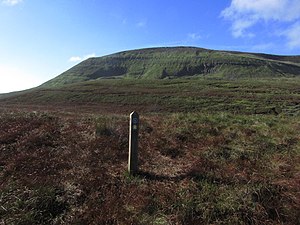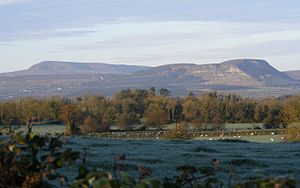Cuilcagh: Difference between revisions
No edit summary |
|||
| Line 32: | Line 32: | ||
==Outside links== | ==Outside links== | ||
*[http://:www.bbc.co.uk/ni/landscapes Landscapes Unlocked] BBC Learning Northern Ireland - Aerial footage from the ''Sky High'' series explaining the physical, social and economic geography of Northern Ireland. | {{commons|Cuilcagh Mountain}} | ||
*[http://:www.bbc.co.uk/ni/landscapes Landscapes Unlocked] BBC Learning Northern Ireland - Aerial footage from the ''Sky High'' series explaining the physical, social and economic geography of Northern Ireland. | |||
==References== | ==References== | ||
Revision as of 13:43, 21 March 2018
| Cuilcagh | |
| Fermanagh, County Cavan | |
|---|---|
 The Ulster Way climbing Cuilcagh | |
| Summit: | 2,182 feet H123280 |
Cuilcagh, historically Slieve Cuilcagh is a mountain on the border of the Counties of Fermanagh and Cavan, and hence on the border of the United Kingdom with the Republic of Ireland. It is the county top of both Fermanagh and Cavan.
Water from the southern slope flows underground until it emerges some miles away in the Shannon Pot in County Cavan, the famed source of the River Shannon.
The mountain’s name is Gaelic and means "chalky peak".
Birds, beasts and blooms
Cuilcagh Mountain has one of the largest expanses of blanket bog in Northern Ireland, on a relatively high elevation upland landscape, bounded by limestone grassland to the north and montane habitats to the south. The blanket bog exhibits a wide range of characteristic vegetation and structural features, with well-developed pool, hummock and lawn features, acid flushes and bog bursts.
The bog vegetation is characterised by luxuriant Sphagnum mosses but over most of the site dwarf-shrubs and graminoid herbaceous species dominate. The Cuilcagh area supports a rich assemblage of upland insects, and is one of the most important sites in Ireland for these species. Species recorded include the water beetles Agabus melanarius, Agabus arcticus, Dytiscus lapponicus, Stictotarsus multilineatus, Hydroporus longicornis and Hydroporus morio and the water bugs Glaenocorisa propinqua and Callicorixa wollastoni. Lough Atona is the main locality for these species.[1]
Geopark

In 2007 the Cuilcagh Mountain Park was joined with popular tourist attraction the Marble Arch Caves and the Cladagh Glen Nature Reserve to make the Marble Arch Caves and Cuilcagh Mountain European Geopark. In September 2008 the park was given UNESCO Global Geopark status under the name of the Marble Arch Caves Global Geopark. The Geopark is protected and managed by the local council through the staff of the Marble Arch Caves Visitor Centre.
Ramsar site
The Cuilcagh Mountain Ramsar site (wetlands of international importance designated under the Ramsar Convention), is 6,782 acres in area, at 54° 13’ 26” N, 07° 48’ 17” W. It was designated a Ramsar site on 31 December 1998. The site qualified under Criterion 1 of the Ramsar Convention because is a large and relatively intact example of a blanket bog and one of the best examples of this habitat in the United Kingdom.
The site also contains a comparatively high-altitude example of an oligotrophic lake, Lough Atona. The site also qualified under Criterion 2 because it supports numbers of rare, vulnerable or endangered species. It is one of the most important upland breeding sites in Northern Ireland for the golden plover, an Irish Red Data Book Species. Other Irish Red Data book bird species occurring on the site include merlins. The bog is also occasionally used for feeding by greater white-fronted geese.[2]
History
In the 1609 Plantation of Ulster, Cuilcagh formed part of lands which were granted to John Sandford Esq. by letters patent dated 7th July 1613 (Pat. 11 James I – LXXI – 38, Quilkagh). It was later granted to Sir Toby Caulfield, Master of the Ordnance by letters patent of 12th July 1620 (Pat. 19 James I. XI. 45, Quilkagh).
Outside links
| ("Wikimedia Commons" has material about Cuilcagh) |
- Landscapes Unlocked BBC Learning Northern Ireland - Aerial footage from the Sky High series explaining the physical, social and economic geography of Northern Ireland.
References
- ↑ "Designated and Proposed Ramsar sites in Northern Ireland" (PDF). Joint Nature Conservation Committee. http://www.jncc.gov.uk/pdf/RIS/UK12005.pdf. Retrieved 2008-07-07.
- ↑ "Designated and Proposed Ramsar sites in Northern Ireland" (PDF). Joint Nature Conservation Committee. http://www.jncc.gov.uk/pdf/RIS/UK12005.pdf. Retrieved 2008-07-07.
